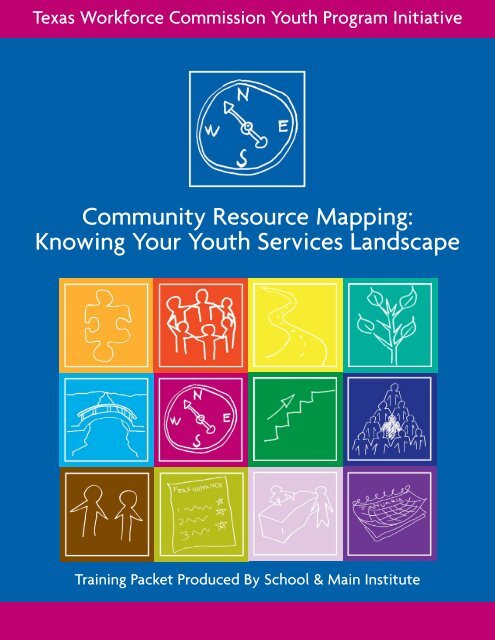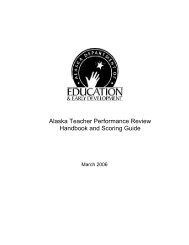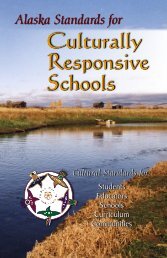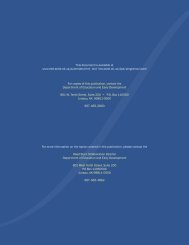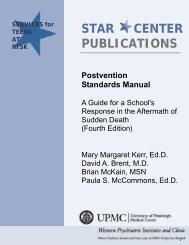Community Resource Mapping - Alaska Department of Education ...
Community Resource Mapping - Alaska Department of Education ...
Community Resource Mapping - Alaska Department of Education ...
- No tags were found...
You also want an ePaper? Increase the reach of your titles
YUMPU automatically turns print PDFs into web optimized ePapers that Google loves.
Texas Workforce Commission Youth Program Initiative<strong>Community</strong> <strong>Resource</strong> <strong>Mapping</strong>:Knowing Your Youth Services LandscapeTraining Packet Produced By School & Main Institute
One <strong>of</strong> twelve training packets created for Texas Workforce Board regions as part <strong>of</strong> the Texas WorkforceCommission Youth Program Initiative.1. Powerful Partnerships2. Getting Your Youth Advisory Group From Here to There3. You and Youth in the Middle: Effective Case Management4. Employer Engagement5. Youth at Work: Making the Most <strong>of</strong> Work-Based Learning6. Youth Investment in Rural Areas7. Windows on the Workplace: Mentoring, Youth, and WIA8. <strong>Community</strong> <strong>Resource</strong> <strong>Mapping</strong>: Knowing Your Youth Services Landscape9. Letting Numbers Guide: Labor Market Information and Youth Services10. Engaging Out-<strong>of</strong>-School Youth11. Building Your Year-Round Youth System12. Evaluate It!: From Policy to Practice to PerformanceYou may download additional copies <strong>of</strong> this packet or any in the series from the Board & Network Partnersarea <strong>of</strong> the Texas Workforce Commission website: www.twc.state.tx.us/customers/bnp/bnp.html.© 2003Produced by School & Main Institute, Boston, MA; Denver, CO; and Austin, TXDesign by Soul Food Design, Cambridge, MATexas Youth Program Initiative Training Packet
<strong>Community</strong> <strong>Resource</strong> <strong>Mapping</strong>: Knowing YourYouth Services LandscapeTRAINING GOALS• Understand when and how you can use resource-mapping strategies to strengthen your WIA initiative.• Set a strong course for your mapping effort by identifying specific uses <strong>of</strong> information you collect.IN THIS PACKETFOOD FOR THOUGHT<strong>Resource</strong> <strong>Mapping</strong>: Fad, Frenzy, or Function?Ready to Map – Knowing What You Want and WhyPurposeProductsPartnersPr<strong>of</strong>ile ElementsStages <strong>of</strong> the <strong>Mapping</strong> ProcessTOOLS FOR ACTION<strong>Mapping</strong> Model One: Surveying Your Youth Services LandscapeFacilitator PreparationParticipant InstructionsOrganization Pr<strong>of</strong>ile - Worksheet 1Our <strong>Resource</strong> Map - Worksheet 2Gaps, Overlaps, Implications, and Action Steps - Worksheet 3Commitment to Action - Worksheet 4<strong>Resource</strong> Base for Your Youth Investment SystemSample <strong>Mapping</strong> Session Invitation LetterSample <strong>Mapping</strong> Session Agenda<strong>Mapping</strong> Model Two: <strong>Mapping</strong> the MoneyFacilitator PreparationParticipant Instructions<strong>Mapping</strong> Youth Services Funding Streams - Worksheet 1Implications and Action Steps - Worksheet 2<strong>Mapping</strong> Model Three: Youth as MappersFacilitator/Staff InstructionsYouth <strong>Mapping</strong> Initiative - Organization Pr<strong>of</strong>ileYouth <strong>Mapping</strong> Initiative - Sample Information Letter<strong>Mapping</strong> Model Four: Employers as <strong>Resource</strong>sEmployer Pr<strong>of</strong>ileGREAT MOMENTS IN RESOURCE MAPPINGMORE GREAT RESOURCESOUR THANKS223345579101112141516171819202122232425262729313233343537Texas Youth Program Initiative Training Packet 1
FOOD FOR THOUGHT<strong>Resource</strong> <strong>Mapping</strong>: Fad, Frenzy, or Function?<strong>Resource</strong> mapping – a process that enablescommunity members to identify or inventoryexisting services and organizationsmatched to a particular purpose – is all therage! Youth workers, healthcare providers,housing activists and urban developers,librarians, social scientists, Peace Corpsvolunteers, technology planners,environmentalists, and college students areall doing it.Is mapping just the latestcommunity development fad?The practice certainly isn’t new. Settlementhouse workers created community resourcemaps in the 1890’s and Harlem youthfanned out in the 1930’s to identifyresources in their neighborhoods 1 . In theearly 1990’s, two community developmentsparkplugs, John McKnight and John P.Kretzmann from Northwestern University,helped lead a resurgence <strong>of</strong> the practice. Inthe past ten years, hundreds <strong>of</strong>communities and community organizationshave carried out resource mappingactivities.As with any big wave, a number <strong>of</strong> forces(moon, seasons, winds, and tides!) combineto help it gain energy and momentum.There are good reasons more and morepeople fold mapping strategies into theirwork. In recent years, we’ve experienced:• Increasing competition for resources,especially the recent economic downturnand funding cutbacks.• A deep interest in one-stop ormulti-service delivery approaches, whichtend to be more comprehensive,accessible, and customer-friendly.• Better technology tools – databases, theweb, and geographic information systems<strong>of</strong>tware – make it easier to collect anddisplay mapping data.So, no, mapping isn’t a fad! We live in anera when it is critical and likely will be for awhile. It should be a function <strong>of</strong> what youdo, an engrained behavior at all levels <strong>of</strong>your workforce investment initiative, fromthe board to provider staff.WIA asks communities to deliver multipleservices via multiple providers for a broadrange <strong>of</strong> youth – in-school, out-<strong>of</strong>-school,special needs, etc. It’s a distinct changefrom the days when one provider deliveredall programmatic elements. If ever therewas a scene ripe for mapping, this is it.This training packet covers the ins and outs<strong>of</strong> resource mapping. You’ll look at why andwhen to do it, possible outcomes, keystages <strong>of</strong> the process and variations, andlessons learned. You will also find tools andinstructions you can use to conduct yourown resource mapping activities.• A general shift from deficit(or needs-based) to asset-based (orcapacity-building) approaches incommunity and “people” development.• An acknowledgement that a quartercentury <strong>of</strong> categorical programdevelopment and community innovationhas scattered a rich, but largelyunconnected, array <strong>of</strong> services acrosscommunity landscapes.1Raise Your Voice: <strong>Community</strong> <strong>Mapping</strong> <strong>Resource</strong> Guide. Campus Compact, Brown University,Providence, RITexas Youth Program Initiative Training Packet 2
FOOD FOR THOUGHTReady to Map - Knowing What You Want and WhyMantra: mapping is strategy, not just directoriesThe notion <strong>of</strong> mapping – taking stock <strong>of</strong>what already exists – makes so much sense.So much sense, in fact, that many peoplejump right in only to look up later fromunder a mass <strong>of</strong> data to realize that datacollection is only a small part <strong>of</strong> theprocess. Many unfinished, underutilized, orout-<strong>of</strong>-date resource guides and databasesresult!The main stages and steps <strong>of</strong> the mappingprocess are relatively straightforward. Thereare plenty <strong>of</strong> variations, however,depending on what you hope to achieve.And that is the trick! <strong>Mapping</strong> isn’t justabout directories, lists and resourcedatabases, although they steal thelimelight. <strong>Resource</strong> mapping isfundamentally a strategic activity.Let this be your mapping mantra:RESOURCE MAPPING IS STRATEGY, NOT JUSTDATA AND DIRECTORIES. RESOURCEMAPPING IS STRATEGY….Beyond the data itself, where do you wantmapping to take you? And do you have agroup <strong>of</strong> partners who can help you dealwith the implications <strong>of</strong> what you discover?Here are four areas you should explore first,so you know WHY and WHEN you mightwant to map before you get into HOWyou’ll map:PURPOSEPRODUCTSPARTNERSPROFILE ELEMENTSPURPOSE: WHY DO WE NEED TODO THIS?People map for many reasons: to knowwhat exists, for strategic or tactical reasons,or perhaps because they have a specificproduct or priority in mind. You would usedifferent steps to create a directory <strong>of</strong> areayouth service case managers than youmight to increase collaboration among areaorganizations. Asking employers to look atcurrent involvement or opportunities foryouth would take you down a completelydifferent path. All three are “mapping”exercises.Talk with other staff at your organization orwith potential partners about why andwhen you want to map – and get as specificas you can about the reasons. How doesmapping fit into the way your group doesbusiness, both now and in future years?For example, a new group <strong>of</strong> youth servicepartners <strong>of</strong>ten needs a baseline snapshot <strong>of</strong>who is doing what with youth in the community.A more established board, council,or community group might do targetedmapping each year, in support <strong>of</strong> a majorgoal. This year, partners will examineresources that support out-<strong>of</strong>-school youth;next year, employer resources as part <strong>of</strong> anemployer participation campaign.Just like regular maps. People keep lookingat them until they reach their destination –and get new ones if they want to venture<strong>of</strong>f in new directions.take action!mapping purposeReview your group’s missionand goals. Where and whenwould mapping – knowingmore about community organizationsand resources – helpyou achieve those goals?Specifically, what informationwould be helpful now and infuture years as your effortmatures?Texas Youth Program Initiative Training Packet 3
FOOD FOR THOUGHTCollect to connect. Collect to affect.WHY PEOPLE MAP• Learn more about a community or area <strong>of</strong>their community• Identify service strengths andopportunities• Pinpoint gaps or redundancies• Identify potential contractors• Examine the level and quality <strong>of</strong> servicesfor a particular area or group• Convene and connect youthorganizations; review relationships andthe level <strong>of</strong> collaboration amongorganizations; identify new ways <strong>of</strong> workingtogether• Engage critical community leaders instrategic planning• Examine programmatic “nuts & bolts” t<strong>of</strong>ind intersections between tools,practices, training needs, and activities• Identify expertise that can be sharedacross programs• Create a resource directory or database<strong>of</strong> area services and organizations• Create a referral list• Improve personal connections• Increase informal connections andnetworking between programs• Identify cost-sharing or fund-poolingopportunities; find new fundingopportunities or strategies• Conduct a needs assessment beforedeveloping a new program or service• Establish a common way to group orcategorize services and/or pr<strong>of</strong>ileorganizationsYou may read the list and think, “We wantto achieve all <strong>of</strong> those things.” That’s fine!But don’t let yourself <strong>of</strong>f the hook. Pushyourself to identify specific goals. What ismost important or what do you needmapping to help you achieve?PRODUCTS: WHAT WILL WEDOWITH THE DATA?Many would-be mappers go on automaticpilot: “Must have directory, must havedirectory, must have directory….” Rememberyour mantra: <strong>Mapping</strong> is strategy, not justdata.There are many ways you might use theinformation you collect – and many toolsyou can produce that could support youryouth development strategies. Which, ifany, will be useful, and depending on yourultimate purpose, maintainable?!Today’s technology tools allow you tocreate and share information in glitzy,sophisticated ways for a relatively smallcost. A Housing and Urban Developmentmapping initiative incorporated GIS(geographic information system)technology. On the other hand, most datahas a short shelf life. You collect it andpost it to your cool web site, and itchanges within months.Brainstorm a range <strong>of</strong> possible products,and discuss how exactly they would servethe cause! Dig into the details – you’ll get amuch better sense <strong>of</strong> specific informationyou need to collect. Don’t, and you’ll findyourself saying, “Oh, we should have askedthat also.” Note that the term “product” isused loosely here to mean any number <strong>of</strong>tools, materials, plans produced to helppeople take action.take action!products & usesAssume you can collectorganizational information andchurn out a directory <strong>of</strong> it.Beyond that, what tools ormaterials would helporganizations work better –and better together – as aresult <strong>of</strong> the information?Texas Youth Program Initiative Training Packet 4
FOOD FOR THOUGHTWHAT PEOPLE GENERATE - EXAMPLES• A mailing list• An online map with the locations <strong>of</strong>services and organizations• An online directory <strong>of</strong> resources,searchable by service type, age level,geographic region• A directory <strong>of</strong> referral resources forWIA-eligible youth• A list <strong>of</strong> potential partners for anupcoming venture• A list <strong>of</strong> places you can market WIAservices or recruit youth, employers, orothers needed to strengthen services• A “Top 10” set <strong>of</strong> service or resource gapsthat partners need to address• Partnership goals and action plan• An inventory <strong>of</strong> employers who sponsorwork-based learning opportunities foryouthPARTNERS: WHO ELSE NEEDS TOBE INVOLVED IN ORDER TO GETAND USE THE INFORMATIONEFFECTIVELY?Before you get too far along, involvepartners. They bring access, energy, andknowledge you may not have. In fact, ittakes the muscle and smarts <strong>of</strong> a coregroup <strong>of</strong> partners to deal with theimplications <strong>of</strong> mapping information!Who are the necessary or potentialcollaborators for your effort? Who elsewould value or benefit from theinformation you collect or results you hopeto achieve? Who else might need to map insimilar fashion? Or who has alreadyparticipated in a mapping or servicesinventory effort? These days don’t besurprised to find partners who have!Most mapping efforts involve dozens, evenhundreds, <strong>of</strong> organizations. Staff mayparticipate in a mapping session orcontribute organizational information. Intheory, all <strong>of</strong> these organizations representpotential partners. In practice, however,look for a set <strong>of</strong> “spark plug partners” – acore group <strong>of</strong> organizations who can giveyour effort the momentum it needs.POWERFUL MAPPING PARTNERS -EXAMPLES• Youth or youth programs• Chambers <strong>of</strong> Commerce, Rotaries, andother business or industry groups• Libraries• Social or human service agencies• <strong>Community</strong>-based organizations ornetworks such as the United Way• PTA or PTO’s• Counseling department <strong>of</strong> a local college• City or county government; the mayor’s<strong>of</strong>ficePROFILE ELEMENTS: WHATINFORMATION DO WE WANT TOMAP?When you map, you want to know morethan the fact that a resource exists. Youneed details! What information do peopleneed in order to understand a potentialresource and the specific assets itrepresents? <strong>Mapping</strong> is pr<strong>of</strong>iling – and thebetter a handle you have on what partnersneed to know, the more powerful mappingwill be.WHAT MAPPERS MAP:• Basic organizational contact information• Population served; number <strong>of</strong> youth thatcould be served (capacity)• Geographic areas served• Types <strong>of</strong> services or core activities• Funding streams• Programmatic and/or staff expertise• Tools and systems used• Partners, affiliations, and networks• Volunteer recruitment/outreachstrategiestake action!partnersMake a list <strong>of</strong> theorganizations, programs, andcommunity leaders you want toinclude in your mapping effort.Put a star next to at least 4-5critical organizations or people– partners who can co-sponsoror promote the effort and whohave enough clout toimplement changes ordecisions based on what youdiscover.Texas Youth Program Initiative Training Packet 5
FOOD FOR THOUGHTWhat do you need to know…now?Once you establish a good working list,review it and pick the most importantelements. Always balance your “need toknow” with a “what you need to knownow” reality check. <strong>Mapping</strong> is usually abeginning, not an end, so keep the list forfuture, deeper mapping moments.You may need to negotiate elements. Theelements you pick give <strong>of</strong>f a clearindication <strong>of</strong> the scope, scale, and aims <strong>of</strong>your mapping effort. Partners orstakeholders have different interests andeveryone wants to make the most <strong>of</strong> theprocess. Your program may care only aboutcareer preparation services for 14 to 24-yearolds. Some organizations won’t feelcomfortable sharing certain informationuntil a certain level <strong>of</strong> trust is established.take action!pr<strong>of</strong>ile elementsMake a list <strong>of</strong> the main elementsor characteristics –organizational, programmatic,etc. – <strong>of</strong> a ‘resource’ you wantto pr<strong>of</strong>ile. Jog your thinking byconsidering your ownorganization’s main activitiesand characteristics. Identifyareas you already knowintersect, duplicate, orcompete with the work <strong>of</strong>other organizations.The more partners involved, the more likelythe scope <strong>of</strong> your mapping effort willbroaden. You will probably hit a momentwhen you say: “Well, I’m collecting thisinformation. I may as well collect that aswell.” Resist the “while we’re at it” urge.If the scope broadens, revisit the elementsyou want to pr<strong>of</strong>ile and what you need topr<strong>of</strong>ile to accomplish current goals.Otherwise, you risk diluting theeffectiveness <strong>of</strong> your effort andantagonizing partners with cumbersomeinformation requests. You can always digdeeper later – as relationships deepen.Texas Youth Program Initiative Training Packet 6
Stages <strong>of</strong> the <strong>Mapping</strong> ProcessFOOD FOR THOUGHTFinally, the mapping process itself! Here arethe six basic stages <strong>of</strong> mapping. Sometimesthe stages get condensed into the timeframe <strong>of</strong> a single meeting or retreat-styleevent. Other times, they flow over thecourse <strong>of</strong> several months. Look in theTools section <strong>of</strong> this packet for fourvariations on mapping – methods youthand workforce development initiativesaround the country use. You’ll also findinstructions and tools so that you can dothem in your community.PREPARATION & PROMOTION✓ If you skipped straight to this section, goback and review the first four “P’s” <strong>of</strong>mapping! They not only push you toarticulate clearly what you want to doand why, but they also help draw outimportant design considerations.✓ Scout around to see if any youthorganizations you know have doneresource mapping.✓ Identify a dynamic yet neutral convener.Is there a person, organization ororganizations that could jump-start orpromote your mapping effort?✓ Create a small planning committee madeup <strong>of</strong> partner and providerrepresentatives.✓ Outline the type <strong>of</strong> information youwant to collect or compare acrossorganizations.DATA COLLECTION✓ Identify the forum and formats you willuse to collect data. Many mappersprepare an organizational pr<strong>of</strong>ile orsimilar tool and distribute it to likelyresource prospects. Others use interviewsto gather data. Others invite peopleto a resource-mapping event to kickthings <strong>of</strong>f.✓ Create the tools you need, i.e., anorganizational or program pr<strong>of</strong>ile formbased on the elements you want tocompare across organizations; a survey;interview protocol, or list <strong>of</strong> questionsinterviewers need.✓ Orient anyone who will help collectinformation.✓ Formally invite people and organizationsto participate. Go straight to leadership!✓ Collect your data.ANALYSIS & DISCOVERY✓ Determine where and how people willreview the data. You might conveneorganizational representatives to do thisor ask a team <strong>of</strong> people to prepare apresentation.✓ Analyze the information and outlinefindings: major discoveries, resourcestrengths, connections, gaps andimplications.✓ Present findings. If you plan to ask anorganization for information, plan toshare what you learn. So many timesmappers collect information andparticipants never see the results.✓ Flag any areas that will require deepermapping. Often, you learn enough aboutother organizations or services to seepossible connections, but theinformation isn’t granular enough toknow how best to connect. Be preparedfor a second wave <strong>of</strong> mapping, usuallycarried out by staff members who knowthe most about a particular area ortopic.ACTION PLANNING & PRODUCTCREATION✓ Review findings, and with partners,outline action steps. Make sure youidentify several actions you canaccomplish within a short timeframe –6 months to a year maximum – at no orvery little cost. <strong>Resource</strong> mapping canrun you into larger issues. If you can’tget some immediate impact or “win,”people will quickly lose faith in theprocess.Texas Youth Program Initiative Training Packet 7
FOOD FOR THOUGHT✓ Create any products – strategic plans,referral lists, directories, etc. – youwant. Identify who will update theinformation, how, and how <strong>of</strong>ten.✓ Present your action plan and finalproducts to organizations thatparticipated. As with your initial findings,communicate the upshot <strong>of</strong> all thismapping business to organizationsinvolved!RESULTS✓ Provide partners and participatingorganizations with short updates onaction item progress and other results<strong>of</strong> your mapping process. In fact, markyour calendar for 1-month, 6-month,and 1-year updates. Think <strong>of</strong> it this way:You need to prove that the informationand findings didn’t disappear into ablack hole.REVISIONS✓ If appropriate, establish a regularschedule or method for keeping yourmapping information and productsfresh. Should people send you changes,or will you seek them, i.e., at naturalpoints in the year?✓ Get feedback on the process. Do peoplefeel like the methods and tools helpthem articulate clearly what they doand how they might work with otherlike-minded organizations? Make anyadjustments you need.Texas Youth Program Initiative Training Packet 8
TOOLS FOR ACTIONTexas Youth Program Initiative Training Packet9
<strong>Mapping</strong> Model One: Surveying Your Youth ServicesLandscapeOverviewThe Main Idea: An event or retreat convened by a local youth organization(s) that brings togetherpeople who actively participate in a community’s youth services network.How Long It Takes: Half or full day session/retreat; 1-2 months lead and preparation timeThe Purpose: Awareness, needs assessment, visioning, and initial strategic planning• Introduce key players to each other and build general awareness <strong>of</strong> existing assets• Coalesce core leadership around a common vision for your youth services system• Identify service gaps by age group or type <strong>of</strong> support• Kick-start organizational collaborationThe Main Products• An action plan with initial goals for improved coordination• RelationshipsWhat It Won’t Necessarily Do for You• Provide information on EVERY possible resource. This is a good example <strong>of</strong> mapping used as strategy –to form and build a critical mass <strong>of</strong> organizational relationships – not necessarily to capture detailedorganizational data on all community youth assets (although that can be included as a second phase).• Evaluate the QUALITY <strong>of</strong> resources and servicesTOOLS FOR ACTIONWhat It Looks LikeA lead organization or partnership invites 25-40 potential partners or stakeholders to a half or full day“mapping session.” In advance <strong>of</strong> the session, staff members from each organization attending complete aself-assessment tool, survey, or pr<strong>of</strong>ile <strong>of</strong> their programs and services. With pr<strong>of</strong>ile in hand, a team/representative attends half or full day mapping and planning session.At the session, teams compare and contrast pr<strong>of</strong>ile information to identify “gaps, overlaps, and intersections”across organizations. For example, they look at clients served, types <strong>of</strong> services, funding streams, and so on.They make recommendations about potential areas <strong>of</strong> collaboration; new service needs; etc.; and commit toan action plan.Texas Youth Program Initiative Training Packet10
Surveying Your Youth Services LandscapeFacilitator PreparationTOOLS FOR ACTIONFacilitator’s Materials• <strong>Mapping</strong> Worksheets 1-4 (Templates)• Sample <strong>Mapping</strong> Session Invitation Letter• Sample Session AgendaInstructions1. Find the following mapping tools in this packet:• Organization Pr<strong>of</strong>ile – Worksheet 1• Our <strong>Resource</strong> Map – Worksheet 2• Gaps, Overlaps, Implications, and Action Steps – Worksheet 3• Commitment to Action – Worksheet 4The first column <strong>of</strong> each worksheet lists suggested “mapping elements.” You may want to customize the itemsso that they reflect the information you most want people to provide and analyze. The first column should beidentical on the three worksheets – same categories, in the same order, so that rows align when you place thesheets side-by-side.2. Invite people to your session. Your invitation should encourage organizations to send “multilevel” teams –leadership, front line staff, etc. – <strong>of</strong> 3-8 people. Include a copy <strong>of</strong> the Organization Pr<strong>of</strong>ile tool in the invitation.Ask that staff from each organization either a) meet to complete one pr<strong>of</strong>ile for their organization, or b)complete one individually. Either way is fine. Teams <strong>of</strong>ten don’t have time to meet to do a single pr<strong>of</strong>ile and it’sinteresting to see how different people within the same organization view their own resources.In either case, each participant should bring a copy <strong>of</strong> his or her organization’s pr<strong>of</strong>ile to the session for his orher own use (they will work with other organizations and will need the information). They should make andbring one extra copy for you. Note that you could also collect pr<strong>of</strong>iles in advance and prepare handouts for thesession; however, experience shows that it is better to let teams report the information as part <strong>of</strong> the sessionitself.3. In advance <strong>of</strong> the session, create giant 4’ x 6’ wall versions <strong>of</strong> the “Our <strong>Resource</strong> Map” and “Gaps, Overlaps,Implications, and Action Steps” worksheets. Session participants will use them to record and review pr<strong>of</strong>ileinformation. You’ll need one set <strong>of</strong> worksheets per table/team. Note that you may need to make 2-3 copies <strong>of</strong>Worksheet 2 so that each organization represented at a table can post information.4. At the session, provide a complete set <strong>of</strong> all materials for each table:• Flip chart, colored markers, and masking tape• One set <strong>of</strong> wall-sized mapping Worksheets 2 and 3, “Our <strong>Resource</strong> Map” and “Gaps, Overlaps, Implications, andAction Steps” posted side-by-side• One complete set <strong>of</strong> worksheets, 1-4, per person• A copy <strong>of</strong> the <strong>Mapping</strong> Session agenda5. Ask representatives from the same organization to sit at the same table at the start <strong>of</strong> the session. Use tablemarkers to help direct people to the right location. Seat “solo” participants (they are the only representativefrom their organization) at the same table.Texas Youth Program Initiative Training Packet11
Surveying Your Youth Services LandscapeParticipant InstructionsTOOLS FOR ACTIONGoal• Learn about the expertise and resources community organizations can bring to the “youth investmenttable.”• Identify specific areas <strong>of</strong> potential or increased coordination and collaboration.<strong>Mapping</strong> Tools & Materials• Organization Pr<strong>of</strong>ile - Worksheet 1• Our <strong>Resource</strong> Map - Worksheet 2• Gaps, Overlaps, Implications and Action Steps - Worksheet 3• Commitment to Action - Worksheet 4• <strong>Resource</strong> Base for Your Youth Investment System - HandoutActivity One: YOUR ORGANIZATION PROFILEtime: 10 minutesReview your Organization Pr<strong>of</strong>ile worksheet with other members <strong>of</strong> your organization. Make sure thatinformation is complete and captures all the knowledge your group has. If you didn’t complete a pr<strong>of</strong>ile, do sonow.Activity Two: OUR RESOURCE MAPtime: 60-90 minutes1. For this activity, you’ll compare and contrast your organization with others in the room. Dispatch members <strong>of</strong>your organization’s team to other tables. Introduce (reintroduce) yourself to the members <strong>of</strong> your new table.Give a 1-minute overview <strong>of</strong> your organization.2. Next, take turns transferring important information from your organizational pr<strong>of</strong>ile to one column <strong>of</strong> the wallsized“Our <strong>Resource</strong> Map” worksheet. Several table members should be able to work at once (without elbowingeach other!). If more than one representative from your organization is at the table, take turns pr<strong>of</strong>iling differentelements.3. When you finish, have a representative from each organization give a 1-2 minute review <strong>of</strong> their organization’spr<strong>of</strong>ile information to everyone else at the table.4. Now, analyze your resource map. Use the Gaps, Overlaps, Implications and Actions Steps worksheet to guideyou.• What patterns do you see?• What are the points <strong>of</strong> intersection between groups?• Are there any service gaps? Opportunities?• Where is there overlap or duplication?List the main implications you see and discuss how you might address them. Keep notes – especially on actionsteps your group recommends. Have one person record your major findings and recommendations on a flipchart. (30 minutes)Texas Youth Program Initiative Training Packet12
Surveying Your Youth Services LandscapeParticipant Instructions, ContinuedTOOLS FOR ACTIONActivity Three: COMMITMENT TO ACTIONtime: 30-45 minutes1. Report your table’s recommendations to the full group. (3-4 minutes per group)2. As a large group, work for consensus on action items. Which recommendations can session participants, as agroup, commit to? Which action items could be done immediately or within a short time frame? Who will beresponsible for leading the charge on high priority items?Your facilitator or volunteer recorder will put a Í star next to items you commit to AND that have at least oneperson who volunteers to “make sure it happens.”3. Rejoin your organization’s team (or table where you started the session). Discuss the experiences you hadworking with other organizations. Review the action items targeted by the group and the implications for yourorganization. What do you as individuals or as an organization need to do to support identified goals? Whatare you willing to do? Be accountable for?Have one member <strong>of</strong> your group record your commitments on the Commitment to Action worksheet.4. Report your organization’s commitments to the full group and give your Commitment to Action to the facilitatorso that the information can be recorded and reported in session notes!Texas Youth Program Initiative Training Packet13
TOOLS FOR ACTIONOrganization Pr<strong>of</strong>ile - Surveying Your Youth Services Landscape - Worksheet 1<strong>Mapping</strong> ElementsMy Organization:Mission or PurposeArea and Clients/Ages & Type <strong>of</strong>Youth ServedPrograms,Services,ActivitiesWIA-Related ProgramElements, Expertise,Tools, Best PracticesPartners &Relationships<strong>Resource</strong> Streams/OpportunitiesOther?Other?Texas Youth Program Initiative Training Packet 14
TOOLS FOR ACTIONOur <strong>Resource</strong> Map - Surveying Your Youth Services Landscape - Worksheet 2<strong>Mapping</strong> ElementsPartner or Program: Partner or Program: Partner or Program:Mission or PurposeArea and Clients/Ages & Type <strong>of</strong>Youth ServedPrograms,Services,ActivitiesWIA-Related ProgramElements, Expertise,Tools, Best PracticesPartners &Relationships<strong>Resource</strong> Streams/OpportunitiesOther?Other?Texas Youth Program Initiative Training Packet 15
Gaps, Overlap, Implications, and Action Steps - Worksheet 3TOOLS FOR ACTIONIntersections & Overlap Gaps Implications Action StepsMission or PurposeArea and Clients/Ages & Type <strong>of</strong>Youth ServedPrograms,Services,ActivitiesWIA-Related ProgramElements, Expertise,Tools, Best PracticesPartners &Relationships<strong>Resource</strong> Streams/OpportunitiesOther?Other?Texas Youth Program Initiative Training Packet 16
Commitment to Action - Worksheet 4Action ItemsOur Individual and Organizational CommitmentsTOOLS FOR ACTIONTexas Youth Program Initiative Training Packet 17
<strong>Resource</strong> Base for Your Youth Investment SystemTOOLS FOR ACTIONPEOPLEIDEASEFFECTIVE PRACTICESEXPERTISEAUTHORITYENDORSEMENTACCESSTIMEMATERIALSSUPPLIESSPACEMACHINERYTRANSPORTATIONOTHER GOODS/SERVICESMONEYDIRECT FUNDINGRESTRICTED FUNDINGMATCHING FUNDSLEVERAGED FUNDSNEW GRANT OPPORTUNITIESTexas Youth Program Initiative Training Packet18
Sample <strong>Mapping</strong> Session Invitation LetterTOOLS FOR ACTIONDear:Our community has wonderful opportunities, activities, and services available for youth. We probably also have afew important gaps or needs we should address. Help us get a snapshot <strong>of</strong> what we have and what we need![Your organization or partnership] is hosting a <strong>Community</strong> <strong>Resource</strong> <strong>Mapping</strong> Session on:[date, time][location]During the session, we’ll look at what different organizations are doing with and for youth and our common goals.Our agenda will include:• Creating a “<strong>Resource</strong> Map” that outlines area services• Analyzing strengths and gaps in our community’s youth support system• Identifying opportunities and areas that need attention• Developing a plan to address gaps and to improve coordination and referral among youth programsWe need your expertise to make the most <strong>of</strong> this opportunity!Fax or mail the enclosed RSVP to [contact name] at [organization] at [fax/address] by [deadline]. Teams are welcomeand strongly encouraged, so please invite members <strong>of</strong> your staff who know your programs and services best.Finally, take a few minutes to complete the enclosed Organizational Pr<strong>of</strong>ile. Bring two copies <strong>of</strong> it with you to thesession – it will help other participants learn as much as they can about you!Thank you for your continued support <strong>of</strong> youth in our community. If you need more information or have questions,give me a call at [phone number].I look forward to seeing you soon,[name, title <strong>of</strong> leader]Enclosure: Organization Pr<strong>of</strong>ileTexas Youth Program Initiative Training Packet19
Sample <strong>Mapping</strong> Session AgendaTOOLS FOR ACTION9:00 am Welcome• Introductions• The Purpose <strong>of</strong> <strong>Mapping</strong>• Overview <strong>of</strong> the Process9:15 am Inside My Organization• Reviewing Your Organization’s Pr<strong>of</strong>ile9:30 am <strong>Mapping</strong> Organizational <strong>Resource</strong>s10:00 am Identifying Strengths, Overlaps, Gaps, and Implications10:45 am Break11:00 am Action Planning12:00 noon Adjourn - LunchTexas Youth Program Initiative Training Packet20
<strong>Mapping</strong> Model Two: <strong>Mapping</strong> the MoneyOverviewTOOLS FOR ACTIONThe Main Idea: Representatives from youth programs meet to learn about and compare funding streams.They explore how they might be used to support a more comprehensive and coordinated approach to youthservices.How Long It Takes: Half or full day meeting/retreat, with 2-4 weeks preparationThe Purpose: Increased resource efficiency or cost sharing, collaborative resource development• Identify matching/pooled, leveraged, new, and overlooked resource possibilities.The Main Products• A funding crosswalk or matrix• Funding coordination planWhat It Won’t Necessarily Do for You• Help diminish competition for resources. Organizations may and will likely continue to tap commonsources.What It Looks LikeThis model is a variation <strong>of</strong> <strong>Mapping</strong> Model One, Surveying Your Youth Services Landscape. Like rivers through avalley, nothing affects your youth services landscape more than the streams <strong>of</strong> funding that supply it. So, inthis variation <strong>of</strong> mapping, you host a mapping session or meeting and make funding the focal point.Why would you choose this variation over Model One?• A new policy or funding stream or a major shift in one presents a good opportunity to convene withfunding as the focal point.• A grant opportunity requires partnership/collaboration, matching funds, or pooled resources.• A resource crisis – tight times, budget cuts – makes it wise strategically. All eyes are on funds and howefficiently they are used.• Your youth organization leaders place a high priority on working with other organizations to pool resources,share costs, etc. They have been actively looking for more ways to do this.This type <strong>of</strong> mapping usually involves a smaller group <strong>of</strong> people, <strong>of</strong>ten people who have worked togetherbefore (funds and money can be sensitive topics).Texas Youth Program Initiative Training Packet21
<strong>Mapping</strong> the MoneyFacilitator PreparationTOOLS FOR ACTIONFacilitator’s Materials• <strong>Mapping</strong> Youth Services Funding Streams – Worksheet 1• Implications and Action Steps – Worksheet 2Instructions1. Review the <strong>Mapping</strong> Youth Services Funding Streams worksheet to make sure it captures the information youwant.2. Invite people to your session. Your invitation should encourage organizations to send “multilevel” teams –leadership, front line staff, etc. – <strong>of</strong> 3-8 people. Include a copy <strong>of</strong> the <strong>Mapping</strong> Youth Services Funding Streamsworksheet with the invitation. Instruct members <strong>of</strong> each organization to pr<strong>of</strong>ile any important funding streamsit uses to support youth services and bring copies <strong>of</strong> the pr<strong>of</strong>ile to the session.3. In advance <strong>of</strong> the session, create giant 4’ x 6’ wall versions <strong>of</strong> worksheets 1 and 2 – one set per table <strong>of</strong>participants.4. At the session, provide a complete set <strong>of</strong> all materials for each table:• Flip chart, colored markers, and masking tape• One set <strong>of</strong> wall-sized versions <strong>of</strong> worksheets, posted side by side.• One complete set <strong>of</strong> worksheets (handouts) per person.• Your session agenda5. Have representatives from the same organization sit at the same table to start the session. Use table markers tohelp direct people to the right location. Seat “solo” participants (they are the only representative from theirorganization) at the same table.Texas Youth Program Initiative Training Packet22
<strong>Mapping</strong> the MoneyParticipant InstructionsTOOLS FOR ACTIONGoal• Explore important funding streams, the services they support, and how organizations can coordinate tomaximize available resources.<strong>Mapping</strong> Tools & Materials• <strong>Mapping</strong> Youth Services Funding Streams – Worksheet 1• Implications and Action Steps – Worksheet 2Activity One: YOUR ORGANIZATION’S FUNDING PROFILEtime: 10 minutesReview the <strong>Mapping</strong> Youth Services Funding Streams pr<strong>of</strong>ile you completed before the session with othermembers <strong>of</strong> your organization. Do you need to add or update anything? If you didn’t complete a pr<strong>of</strong>ile, do sonow.Activity Two: OUR FUNDING STREAMS MAPtime: 60-90 minutes1. For this activity, you’ll compare funding streams you have access to with those other organizations can access.Dispatch members <strong>of</strong> your organization to other tables. Introduce (reintroduce) yourself to the members <strong>of</strong>your new table. Give a 1-minute overview <strong>of</strong> your organization and what you do.2. Next, compare the funding streams available in organizations represented by people at your table. Recordinformation about streams and sources on the wall-sized version <strong>of</strong> the <strong>Mapping</strong> Youth Services FundingStreams worksheet. Have different people at the table take turns recording the information.3. Now, analyze your funding resources map:• What patterns do you see?• Are there areas <strong>of</strong> overlap? Do streams have programmatic elements or services in common?• Are you spending resources on similar activities or functions? Which ones?List the main implications you see and discuss how you might address them. Do they suggest waysorganizations might coordinate or pool resources, share costs, etc.? Keep notes. Have one person record yourmajor findings and final recommendations on a flip chart. (30 minutes)4. Report your table’s recommendations to the full group. (3-4 minutes per group)5. As a large group, work for consensus on action items. Which items can session participants, as a group, committo? Which could be done immediately or within a short timeframe? Prepare a final list <strong>of</strong> action items youagree to work on and who will be responsible for coordinating work on each. (30 minutes)Texas Youth Program Initiative Training Packet23
<strong>Mapping</strong> Youth Services Funding Streams - Worksheet 1TOOLS FOR ACTIONFunding Stream: Funding Stream: Funding Stream:SourceFunding Cycle/TimelineYouth Eligible - Ages,Geography, TypeHow Funds AreUsed -Youth Services,Program Elements,Staff DevelopmentThemes, etc.How Funds CannotBe UsedMatching FundsRequiredPartners RequiredOther?Texas Youth Program Initiative Training Packet 24
Implications and Action Steps - <strong>Mapping</strong> Funding Streams - Worksheet 2TOOLS FOR ACTIONImplications & IdeasRecommended ActionsImproved <strong>Resource</strong>CoordinationMatching orPoolingCost SharingContracting/OutsourcingCollaborative<strong>Resource</strong>DevelopmentTexas Youth Program Initiative Training Packet 25
<strong>Mapping</strong> Model Three: Youth as MappersOverviewTOOLS FOR ACTIONThe Main Idea: Youth become mappers and canvas neighborhoods, <strong>of</strong>ten in summer, to identify greatyouth resources and activities.How Long It Takes: 4-8 weeksThe Purpose: Data collection, youth engagement, and public relations• Give youth a strong role in identifying resources available to them• Gather information on programs and organizations, <strong>of</strong>ten in a targeted geographic areaThe Main Products• A directory or database <strong>of</strong> youth programs, services, and referral resources• An excellent group <strong>of</strong> skilled youth interviewers and program advocates!What It Won’t Necessarily Do for You• Assess the quality <strong>of</strong> services, although youth rate how ‘youth friendly’ or accessible they are• Increase collaboration among organizations and organizational leadership. It can increase referrals• Address service gaps and needsWhat It Looks LikeYour organization or partnership hires and trains a team <strong>of</strong> young people to research programs andorganizations, send surveys, call, visit, or do ‘community walks’ to collect detailed information and programmaterials on available youth services. Youth review the data, categorize it (types <strong>of</strong> services, youth served, etc.),and then produce a database, directory, web site, or illustrated maps that show what services existand where. The Academy for <strong>Education</strong>al Development’s National <strong>Community</strong> Youth<strong>Mapping</strong>(http://www.communityyouthmapping.org/Youth/) effort is perhaps best known for this type <strong>of</strong> mapping.Texas Youth Program Initiative Training Packet26
Youth as MappersFacilitator/Staff InstructionsTOOLS FOR ACTIONGoal• Organize and prepare a team <strong>of</strong> young people to survey your community for youth resources andopportunities.<strong>Mapping</strong> Tools & Materials• Youth <strong>Mapping</strong> Initiative - Organizational Pr<strong>of</strong>ile (Template)• Youth <strong>Mapping</strong> Initiative - Sample Information LetterInstructions1. Identify and recruit your youth team. Treat recruitment the way you would an internship or job experience,whether or not you actually pay team members. Prepare a job description, interview potential youth, and getreferences.2. Orient youth to their mission! Outline the general purpose and process <strong>of</strong> your mapping effort, then let youthhelp you outline the specifics:• What information do you need and why?• How will youth collect information? Survey, phone interviews, visits, or a combination <strong>of</strong> methods? Forexample, you may want youth to send out surveys and only do follow-up calls when information is incomplete, unclear, or a survey isn’t returned. On the other hand, you may want to flag a manageable number <strong>of</strong>resources for face-to-face visits or phone interviews.• How will you handle incomplete or missing data?• How will you identify potential resources? Phone book, community or neighborhood “walks,” by interviewingkey people “in the know”?• How will you publicize your mapping effort?3. Finalize the specific resource information you want to pr<strong>of</strong>ile. Customize the Organizational Pr<strong>of</strong>ile to matchyour needs:• Does the Pr<strong>of</strong>ile capture the information you need? Is there other valuable information that would help yourorganization address major goals?• Do you want to make the Pr<strong>of</strong>ile available online? Mail it? Both?4. Train your team. Make sure you cover topics like community resource research and interview techniques, use <strong>of</strong>the pr<strong>of</strong>ile tool, etc. Run through a few practice ‘resources’ to make sure the tools you plan to use do what youneed them to – and that youth feel comfortable using them to interview, record and categorize information.5. Prepare an initial list <strong>of</strong> organizational and community contacts. Who should complete the survey?6. With youth, prepare a letter you can mail along with the survey. The letter could be from youth – you may alsowant to include an endorsement from your program or a community leader and/or a blurb about your youthteam (who’s on it, fun bio information, etc.)Texas Youth Program Initiative Training Packet27
Youth as MappersFacilitator/Staff Instructions, ContinuedTOOLS FOR ACTION7. Send your survey and collect information. If you send youth out into the community to meet, interview, andcomb for resources, provide them with T-Shirts or caps that identify them.8. Create your products. If you plan to make information available for public consumption – a directory or website, for example – prepare a draft that participating organizations can review before it “goes to press.” It’s anextra step but one that <strong>of</strong>ten yields better data (organizations see what other organizations did for theirpr<strong>of</strong>iles!).9. Make a splash with the results <strong>of</strong> your effort! For example:• Have youth ‘”unveil” a copy <strong>of</strong> the directory to the city council, mayor, student councils, or other importantcommunity and youth leaders.• Announce the results in the newspaper. Let people know where they can access the information.10.Ask your youth team to evaluate the project. What worked? What would they change or recommend to otheryouth who undertake a mapping effort?Texas Youth Program Initiative Training Packet28
Youth <strong>Mapping</strong> Initiative – Organization Pr<strong>of</strong>ileTOOLS FOR ACTIONOrganization NameAddress 1Address 2CityStateZipWeb SiteMain PhoneContact PersonContact PhoneEmail AddressType <strong>of</strong> Organization❏ <strong>Community</strong>-based organization/civic❏ Government agency❏ <strong>Education</strong>/training❏ Business, employer, or employer group❏ Workforce development/employment❏ Church or faith-based group❏ OtherYouth Served❏ Early childhood - PK/K❏ Grades PK-5❏ Grades 6-8❏ Grades 9-12❏ Young adults, ages 18-24❏ College❏ Out-<strong>of</strong>-school youth/dropouts❏ Adult services available alsoTypes <strong>of</strong> Services Offered<strong>Education</strong>al❏ <strong>Education</strong>al services❏ General education/training❏ Alternative education❏ Dropout prevention❏ Adult basic education/GED❏ Tutoring/academic support❏ Test preparation❏ Study skills❏ English/ESL support❏ Basic literacy support❏ Basic math support❏ Diagnostics/learning disabilities❏ Youth with disabilities❏ Homeless youth❏ Foster youth; youth exiting foster care❏ Migrant youth❏ Non-native English speakers❏ Juvenile <strong>of</strong>fenders❏ Income eligible youth only (low income)Career & College Readiness❏ Career research and planning❏ College research and planning❏ Interest and skills assessments❏ Career fairs/days❏ Job shadowing; job rotation❏ College exploration & readiness activities❏ Financial aid/scholarshipsCounseling & Health❏ Counseling - general❏ Counseling - substance abuse❏ Counseling - education/career❏ Health/medical❏ Mental health❏ Pregnant and parenting youth supportTexas Youth Program Initiative Training Packet29
Organization Pr<strong>of</strong>ile, ContinuedTOOLS FOR ACTIONWork-Based Learning & Employment❏ Mentoring❏ Paid internships❏ Unpaid internships❏ Cooperative learning (co-ops)❏ Occupational training❏ Apprenticeships❏ Year-round employment❏ Summer employment❏ Work-study❏ Other work experienceOther Youth Opportunities❏ Leadership development❏ <strong>Community</strong> service/youth activism❏ Cultural activities❏ Recreational/sports activities❏ Civic/political activitiesOther Support❏ Housing and shelter❏ TransportationHow Youth Access Services❏ By referral from another agency or program❏ Open access – free services❏ Open access – cost for services❏ Youth must apply/interview❏ Varies by service or programPrograms & Services - DetailsNameShort DescriptionOther important notes & information about this organization:Name <strong>of</strong> Person Who Completed Pr<strong>of</strong>ile/Main Contact:Name:PhoneTitle:Email:Texas Youth Program Initiative Training Packet30
Youth <strong>Mapping</strong> Initiative - Sample InformationLetterTOOLS FOR ACTIONDear [name <strong>of</strong> organization/program director]:This summer a team <strong>of</strong> young people will lead a <strong>Community</strong> <strong>Resource</strong> <strong>Mapping</strong> effort to identify the array <strong>of</strong> programs,services, opportunities, and activities our community currently has available for young people. We knowthere are many great programs out there but felt that youth and their families – even organizations themselves –don’t always know about them or how to access them.We will use the information we gather to create [type <strong>of</strong> product(s) you will create, i.e., a searchable database <strong>of</strong>youth services on the city’s web site].We need your help! You know your organization and services better than we ever could. Please complete theenclosed Organizational Pr<strong>of</strong>ile and fax/mail it back to us by [deadline] at:[return address, fax, for surveys]We are also happy to collect the information by phone or during a visit to your organization. Please call [name] at[phone] if you would prefer one <strong>of</strong> these options.We look forward to hearing from you and learning about your organization! Please don’t hesitate to contact us ifyou have any questions.Sincerely,Texas Youth Program Initiative Training Packet31
<strong>Mapping</strong> Model Four: Employers as <strong>Resource</strong>sOverviewTOOLS FOR ACTIONThe Main Idea: Employers take stock <strong>of</strong> their current youth-related activities and evaluate how and iftheir involvement matches their interests, available opportunities, and youth needs.How Long It Takes: 2-4 weeksThe Purpose: Employer engagement, work-based learning placements and mentors, coordination <strong>of</strong>employer participationThe Main Products• Employer pr<strong>of</strong>iles• A list or database <strong>of</strong> companies, organizations, and industry associations and the types <strong>of</strong> opportunitiesthey have available for youthWhat It Can’t Necessarily Do for You• Get youth organizations to coordinate aspects <strong>of</strong> employer involvement – but it can create a strongrationale to do so.What It Looks LikeEmployers complete a self-assessment or survey that outlines youth involvementactivities and opportunities – mentoring, internships, etc. – and are <strong>of</strong>ten surprised by what they find.Sometimes they uncover more involvement than they knew about. Other times, they aren’t involved in thingsthey would very much like to be (but didn’t know were possible). The National Employer Leadership Council’sEmployer Participation Model (http://www.nelc.org/) served as a guide for a number <strong>of</strong> communities andstates that did this type <strong>of</strong> mapping.Texas Youth Program Initiative Training Packet32
Employer Pr<strong>of</strong>ileTOOLS FOR ACTIONCompanies and businesses in our area have many opportunities available for youth. Help us learn about who is doing whatand for whom! Use this pr<strong>of</strong>ile to take a quick inventory <strong>of</strong> how you are currently involved with youth and youth programs.You can also use it to evaluate whether your involvement matches your interests, available opportunities, and area youthneeds.Types <strong>of</strong> InvolvementGuest Speakers (schools, youth,programs)Assist with Youth ProjectsTutoringCompany ToursMentoringJob Shadowing/Job RotationsCareer Fairs/DaysInterships - PaidInterships - UnpaidApprenticeshipsSummer EmploymentEmploymentStaff/Teacher InternshipsOther (please list)WE DO OFTENWE DOOCCASIONALLYDON’T DO BUTWOULD LIKE TOCAN’T DO/NOTINTERESTEDNOT SURETypes <strong>of</strong> Youth ServedAny Youth or Youth ProgramYounger Youth, Grade PK-5Middle School, Grades 6-8High School, Grades 9-12Older Youth, 18-24CollegeOut-o f-School Youth/DropoutProgramsYouth with DisabilitiesJuvenile OffendersOther (please list)Other information about how you work - or prefer to work - with youth:Do You have a main contact for youth and youth programs? Yes NoName:PhoneTitle:Email:Texas Youth Program Initiative Training Packet33
GREAT MOMENTS IN RESOURCE MAPPINGEXAMPLES FROM THE FIELDIn ERIE COUNTY, NEW YORK, youth participating in Cornell’s Youth Voices program took disposable cameras along for theircommunity asset mapping project. They were asked to photograph “things they viewed as assets in their community”and “things that needed fixing in their community.” Among other things, the data they collected will be used to publicizea mini-grant program to youth-serving agencies and share information on community improvement and service learningprojects.When the CITY OF LONG BEACH, CALIFORNIA, did a <strong>Community</strong> Scan Survey to identify programs with possible linkages toWIA, they sent surveys out with a letter from the mayor – and specifically asked about organizations able to work withspecial populations.TARRANT COUNTY WORKADVANTAGE BOARD, TEXAS, recently started to use their website to collect resource mapping information.They prompt community organizations serving youth to respond using email which includes a quick link to theironline Adult & Youth Initiative Organizational Pr<strong>of</strong>ile. They’ve used asset mapping information to focus service plans anddevelop appropriate requests for proposals.The NEIGHBORHOOD KNOWLEDGE LOS ANGELES (NKLA) web site and NKCA, its statewide counterpart, show what happenswhen community mapping meets GIS (Geographic Information Systems) technology. The site blends public and privatedemographic, housing, lending, and other data – a statistical pr<strong>of</strong>ile <strong>of</strong> neighborhoods – and is starting to incorporateasset mapping information – a more grassroots view <strong>of</strong> neighborhood capacity, resources, and needs.The GLOUCESTER COUNTY YOUTH COUNCIL, NEW JERSEY hired youth to do mapping in 24 municipalities. The Council kicked <strong>of</strong>fthe effort with a Youth Town meeting, aired on local cable (additional town meetings have been held since). Youth,working with a pr<strong>of</strong>essional marketing firm created the Council’s Youth web site and resource directory.THE GULF COAST WORKFORCE BOARD, TEXAS, decided to decentralize their resource mapping process and put youth in thelead. One-Stop based youth teams, accompanied by a staff member, interviewed and collected data from communityemployers and service providers. They’re using the information to create community level and workforce area databases<strong>of</strong> youth services. However, the process yielded much more than data. As a result, employers got to know youth in theircommunity and the mission and services <strong>of</strong> the One-Stop. For several One-Stops, mapping is now a year-round activityfor youth.The BALTIMORE NEIGHBORHOOD INDICATORS ALLIANCE online mapping system allows you to zoom in on a neighborhood to seeboth the “traditional assets” (schools, businesses, stores) and “non-traditional assets” (community organizations and initiatives,resources for youth and families). Site users can also download neighborhood asset information.Texas Youth Program Initiative Training Packet34
MORE GREAT RESOURCESRESOURCES<strong>Resource</strong> <strong>Mapping</strong>• <strong>Community</strong> Builders- Teens Turning Places Around - Project for Public Spaceshttp://www.pps.org/tcb/cy_mapping.htm• Everybody Wins: Involving Youth in <strong>Community</strong> Needs Assessment – Journal <strong>of</strong> Extension, U.S. Cooperative ExtensionSystem http://www.joe.org/joe/1995april/a1.html• Forging <strong>Community</strong> Links: A <strong>Resource</strong> <strong>Mapping</strong> Guide for CTCNet Affiliates http://www.ctcnet.org/mapping.html• <strong>Mapping</strong> <strong>Community</strong> Capacity John McKnight and John Kretzmann, Institute for Policy Research at NorthwesternUniversity http://www.northwestern.edu/ipr/publications/community/mcc.html• <strong>Mapping</strong> for Change: Using Geographic Information Systems for <strong>Community</strong> Development – Local Initiatives SupportCoalition (LISC)http://www.liscnet.org/resources/2002/12/information_991.shtml?Planning+&+Land+Use• National <strong>Community</strong> Youth <strong>Mapping</strong> and <strong>Community</strong> Youth<strong>Mapping</strong> - Center for Youth Development and PolicyResearch, AEDhttp://www.communityyouthmapping.org/ and http://cyd.aed.org/cym/cym.html• Raise Your Voice: <strong>Community</strong> <strong>Resource</strong> <strong>Mapping</strong> Guide - Campus Compacthttp://www.actionforchange.org/mapping/history.html• The Several Forms <strong>of</strong> <strong>Community</strong> <strong>Mapping</strong> – Best Practice Brief (.pdf) – Outreach Partnerships @ Michigan StateUniversity http://outreach.msu.edu/bpbriefs/issues/brief3.pdfPractical <strong>Mapping</strong> Tools• <strong>Community</strong> Information Corps <strong>Mapping</strong> Project /Public Achievement’s Power <strong>Mapping</strong> Toolboxhttp://www.stpaulcommons.org/projects/mapping.htm• Handbook for Supporting <strong>Community</strong> Youth Researchers John W Gardner Center for Youth and Their Families, StanfordUniversity http://gardnercenter.stanford.edu/resources/handbook/• <strong>Mapping</strong> <strong>Community</strong> Assets Workbook (.pdf) – Northwest Regional <strong>Education</strong>al Laboratory Rural <strong>Education</strong> Programhttp://www.nwrel.org/ruraled/publications/com_mapping.pdf• <strong>Mapping</strong> the Who’s, What’s and Why’s <strong>of</strong> <strong>Community</strong> Development and <strong>Community</strong> Building: A 10 Minute SelfAssessment Tool – Forum for Youth Investment http://www.forumforyouthinvestment.org./mappingwhos.htm• Workbooks - Asset Based <strong>Community</strong> Development Institute http://www.northwestern.edu/ipr/abcd/abcdworkbooks.htmlTexas Youth Program Initiative Training Packet 35
MORE GREAT RESOURCESLearning From Others• Berkshire Youth.org – Pittsfield, Massachusettshttp://www.berkshireyouth.org/index.php3• Boston <strong>Resource</strong>Net.orghttp://www.bostonresourcenet.org/• <strong>Community</strong> Information Network – St. Louis, Missourihttp://stlouis.missouri.org/resources/index.html• ConnectRichmond – Richmond, Virginiahttp://oncampus.richmond.edu/connect/• Contra Costa County Online <strong>Resource</strong> Database (CORD) – California• Franklin County, Ohio <strong>Community</strong> Youth<strong>Mapping</strong>http://www.ohiolearningwork.org/cymyouth.asp• Franklin Hampshire Youth <strong>Resource</strong> <strong>Mapping</strong> – Greenfield, Massachusettshttp://www.fhyouth.org/index.htm• Hartford <strong>Community</strong> Information Database – Hartford, Connecticuthttp://198.134.159.10:81/search/• Healthy Children Healthy City Asset <strong>Mapping</strong> Project – Los Angeles, CAhttp://www.healthychildrenhealthycity.org/index.cfm• Jefferson-Lewis <strong>Community</strong> Youth <strong>Mapping</strong> Project – Watertown, New Yorkhttp://www.workforcenewyork.org/promisingpractices/jefflewisyouth.htm• Minnesota Alliance with Youth <strong>Resource</strong> Directory http://www.mnyouth.org/directory/• Neighborhood Asset<strong>Mapping</strong> System - Baltimore Neighborhood Indicators Alliancehttp://www.bnia.org/data/index.html• NYPIRG’s <strong>Community</strong> <strong>Mapping</strong> Assistance Project http://www.cmap.nypirg.org/• Report on Asset <strong>Mapping</strong> <strong>of</strong> Social Services in West Side Park (.pdf) Newark, NJhttp://policy.rutgers.edu/cupr/rcopc/pdf/assetmap.pdf• Youth Services Directory – San Mateo County, Californiahttp://cip.plsinfo.org/ysd.htmTexas Youth Program Initiative Training Packet36
OUR THANKSOur thanks to the many people who helped bring this training series to life:• Board members and staff <strong>of</strong> Texas’ 28 local workforce boards who were easily accessible, frank and thoughtful abouttheir work, and eager to share lessons learned and examples.• TWC staff members who also reviewed drafts and helped us clarify nuances <strong>of</strong> policy, definition, and language.• Texas youth program staff, educators, and workforce pr<strong>of</strong>essionals who participated in or facilitated training coursesusing field test copies <strong>of</strong> packet materials.• The talented crew <strong>of</strong> School & Main Institute coaches and adjunct faculty working closely with Texas boards duringthe preparation <strong>of</strong> these materials.Texas Youth Program Initiative Training Packet 37


